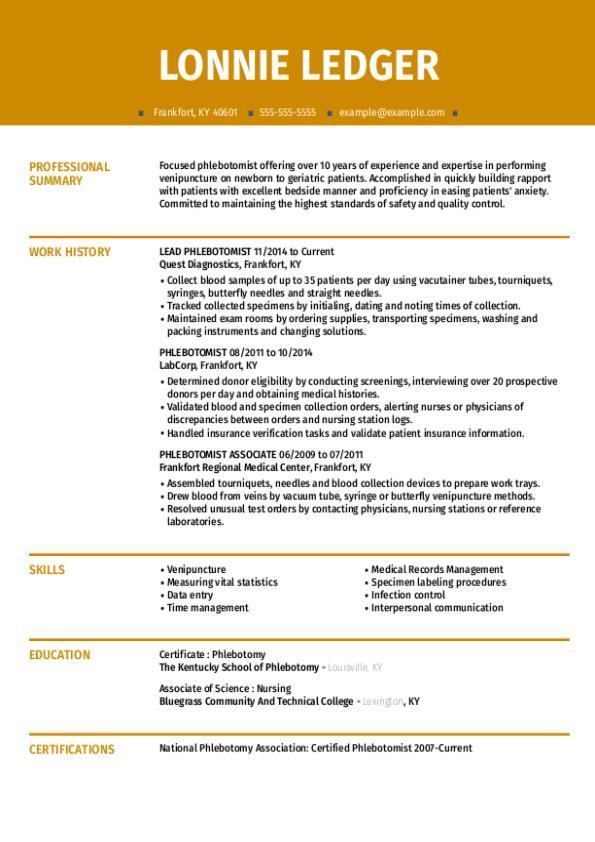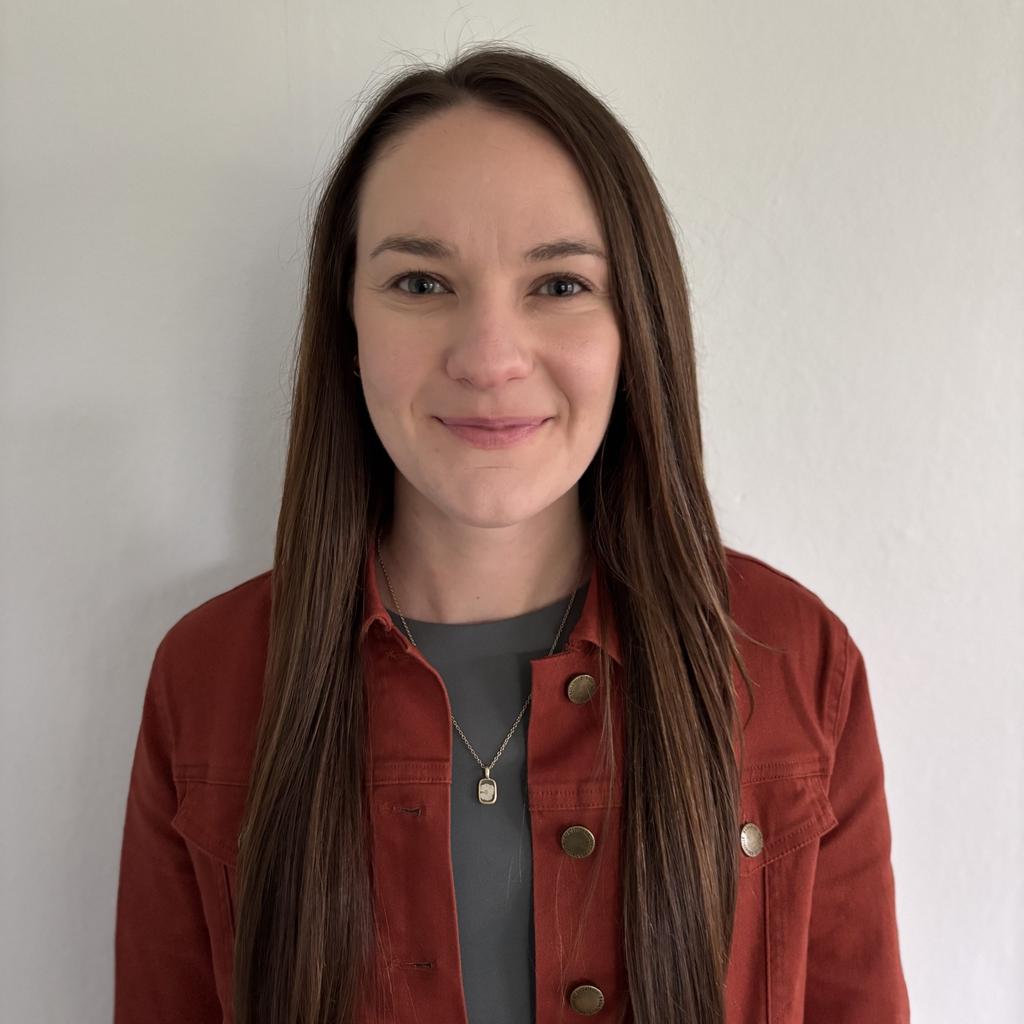Why this resume works
- Quantifies accomplishments: Measurable accomplishments like reducing patient wait times by 30% and training junior staff show the applicant’s impact in healthcare settings.
- Highlights industry-specific skills: Relevant healthcare skills like venipuncture and specimen collection emphasize a strong fit for phlebotomist roles.
- Illustrates problem-solving ability: Creating a new tracking system that boosts accuracy highlights the applicant’s problem-solving skills and critical thinking.
More Phlebotomist Resume Examples
Browse our phlebotomist resume examples to discover how to highlight your skills, experience, and certifications. These healthcare support resume samples will guide you in crafting a resume that effectively showcases your expertise in patient care and laboratory procedures.
Entry-Level Phlebotomist
Why this resume works
- Centers on academic background: The applicant’s education section highlights degrees in biology and medical laboratory science, showing a solid foundation essential for advancing in medical laboratory science early in their career.
- Puts skills at the forefront: Highlighting skills such as venipuncture and data management prominently aligns with the skills-based resume format strategy suited for beginners.
- Shows digital literacy: Efficient patient data entry through inventory management systems showcases the applicant’s computer skills and digital literacy.
Mid-Level Phlebotomist
Why this resume works
- Includes a mix of soft and hard skills: By mixing technical expertise with interpersonal skills, the applicant showcases a balanced skill set for effective patient care and team collaboration.
- Points to measurable outcomes: Listing achievements like boosting satisfaction through patient-centered practices, the applicant emphasizes their ability to deliver measurable improvements in healthcare settings.
- Demonstrates language abilities: The applicant’s language skills in Spanish, German, and French highlight their ability for cross-cultural interaction and communication.
Experienced Phlebotomist
Why this resume works
- Lists relevant certifications: Listing certifications such as Certified Phlebotomy Technician and Basic Life Support reflects a strong dedication to professional growth in healthcare.
- Showcases impressive accomplishments: Achievements like improving patient satisfaction by 37% and reducing lab turnaround time highlight impactful contributions.
- Focuses on work history: Using a chronological resume format to outline roles from medical assistant to phlebotomist showcases an impressive career progression.
Phlebotomist Resume Template (Text Version)
Suki Jones
Minneapolis, MN 55404
(555)555-5555
Suki.Jones@example.com
Professional Summary
Dedicated phlebotomist with 7 years’ experience. Expert in patient care and efficient specimen collection. Proven track record in enhancing workflow and satisfaction.
Work History
Phlebotomist
Summit Health Services – Minneapolis, MN
June 2022 – July 2025
- Collected 1200+ samples monthly for testing
- Reduced patient wait times by 30% through efficiency
- Trained 5 junior staff in phlebotomy techniques
Blood Draw Specialist
Evergreen Diagnostics – Minneapolis, MN
May 2019 – June 2022
- Handled 150+ patient samples weekly
- Educated 10+ patients daily on procedures
- Developed a new tracking system, increasing accuracy
Healthcare Technician
Riverside Medical Group – Cedar Valley, MN
April 2016 – April 2019
- Assisted with 200 outpatient procedures
- Improved sample handling by 25% via new protocols
- Managed patient records for the entire facility
Languages
- Spanish – Beginner (A1)
- French – Intermediate (B1)
- Mandarin – Beginner (A1)
Skills
- Venipuncture
- Specimen Collection
- Patient Care
- Laboratory Techniques
- Data Entry
- Team Leadership
- Patient Education
- Attention to Detail
Certifications
- Certified Phlebotomy Technician (CPT) – American Society of Phlebotomy Technicians
- Basic Life Support (BLS) – American Heart Association
Education
Master of Science Clinical Laboratory Science
University of Illinois Urbana, Illinois
May 2014
Bachelor of Science Biology
Illinois State University Normal, Illinois
May 2012
Related Resume Guides
Advice for Writing Your Phlebotomist Resume
Explore our tips on how to write a resume tailored for a phlebotomist position. Discover how to highlight your skills in blood collection, patient interaction, and lab procedures, setting you apart in the medical field.

Write a strong professional summary
A professional summary on a resume serves as an introduction for hiring managers, providing a snapshot of your skills and accomplishments. You can decide whether to use a summary or a resume objective based on your experience level and career goals.
A professional summary includes three to four sentences that highlight your experience, skills, and achievements. It’s ideal for those with some work history who want to express their professional identity and show the value they bring to the table.
Conversely, a resume objective focuses on career goals and works well for entry-level individuals, those switching careers, or people with employment gaps. It emphasizes “what I aim to contribute” instead of past accomplishments.
Next, we’ll explore examples of both summaries and objectives tailored for different industries and experience levels to help you make an impactful first impression as a phlebotomist. See our library of resume examples for additional inspiration.
Phlebotomist resume summary examples
Entry-level
Recent phlebotomy program graduate with hands-on training in blood collection, sample preparation, and patient interaction. Certified Phlebotomy Technician (CPT) with knowledge of safety protocols and basic laboratory procedures. Eager to contribute skills in a clinical setting while providing compassionate care and maintaining high standards of accuracy.
Mid-career
Experienced phlebotomist with over five years in hospital and clinic environments. Proficient in venipuncture, capillary draws, and specimen handling for various tests. Known for excellent patient relations, efficiency under pressure, and adherence to strict health regulations. Holds certification from the American Society for Clinical Pathology (ASCP) and has a track record of minimal error rates.
Experienced
Seasoned phlebotomist with 15+ years of experience in diverse healthcare settings, including oncology and pediatrics. Expert in advanced techniques such as arterial punctures and central line draws. Proven leadership abilities with experience supervising junior staff and managing lab operations. Committed to improving patient outcomes through precise specimen collection and collaborative teamwork.
Phlebotomist resume objective examples
Recent graduate
Energetic and dedicated recent graduate with a certificate in phlebotomy seeking an entry-level phlebotomist position to apply practical skills and knowledge in blood collection procedures. Committed to ensuring patient comfort and safety while contributing to efficient laboratory operations.
Career changer
Passionate individual transitioning into the healthcare field as a phlebotomist, leveraging previous experience in customer service and attention to detail. Eager to bring interpersonal skills and precision to a team-focused medical environment, improving patient care experiences.
Specialized training
Certified phlebotomy technician with specialized training in venipuncture techniques seeking a role in a progressive healthcare facility. Excited to use hands-on expertise and keen observational skills to support accurate specimen collection processes and improve laboratory efficiency.
You can use our Resume Builder to create your phlebotomist resume. Choose a professional template, add your details, and make a strong impression on employers.
Include relevant certifications and training
Listing certifications and training on your resume shows that you have the skills and knowledge needed to perform as a phlebotomist. Employers often require specific credentials to ensure you can handle blood collection safely and efficiently.
Having these certifications also sets you apart from others by proving you’re prepared for the technical demands of the role. A clear certifications section helps hiring managers quickly see your qualifications. Here are a few examples of certifications for your resume:
- Certified Phlebotomy Technician (CPT)
- National Certified Phlebotomy Technician (NCPT)
- Registered Phlebotomy Technician (RPT)
- Basic Life Support (BLS) Certification
- Occupational Safety and Health Administration (OSHA) Bloodborne Pathogens Training
Including certifications like these shows employers you’re ready for the responsibilities of a phlebotomist. Highlighting them alongside your education helps strengthen your resume and makes it clear you meet industry standards. This gives hiring managers confidence in your abilities right away.
Example of a certifications section
Certified Phlebotomy Technician (CPT)
Issued by: American Society for Clinical Pathology (ASCP)
Issued 2022
Registered Phlebotomy Technician (RPT)
Issued by: American Medical Technologists (AMT)
Expires 2025
Phlebotomy Technician Certification
Issued by: National Healthcareer Association (NHA)
Issued 2023
Basic Life Support (BLS) Certification
Issued by: American Heart Association
Expires 2024
Certified Donor Phlebotomist Technician
Issued by: American Red Cross
Issued 2023
Use a polished and well-organized resume template that effectively showcases your skills and qualifications to stand out to hiring managers in the healthcare field.
Showcase your work experience
Detailing your work experience is key when writing a resume for a phlebotomist job. It helps employers understand your background and how your experience aligns with the role they’re hiring for. Start with your most recent job and list your positions in reverse chronological order.
For each role, include your job title, employer name, location, and dates of employment. Use strong action verbs to describe your responsibilities and accomplishments—this adds impact and makes your experience stand out.
Whenever possible, highlight measurable achievements. For example, mention if you collected blood samples from a high volume of patients daily or helped reduce wait times by streamlining sample collection processes. Including specific numbers shows the tangible impact of your work.
Be sure to outline core responsibilities specific to phlebotomy, such as drawing blood, labeling specimens accurately, maintaining patient records, and ensuring equipment cleanliness and compliance with safety protocols.
These details help employers see your qualifications clearly and demonstrate your readiness for the role. By focusing on both your technical skills and real-world results, you’ll create a strong, compelling work experience section tailored to a phlebotomist position.
5 phlebotomist work history bullet points
- Collected blood samples from over 100 patients daily, ensuring accurate labeling and timely delivery to the lab.
- Implemented a new patient tracking system, reducing sample mix-ups by 40%.
- Trained 15 new hires on phlebotomy techniques and safety protocols, improving team efficiency by 25%.
- Conducted regular inventory checks and managed supply orders, resulting in a 20% reduction in stock shortages.
- Collaborated with healthcare providers to streamline patient care processes, improving overall patient satisfaction scores by 10%.
For phlebotomists, using a resume format that highlights your technical skills, patient interaction experience, and certifications can improve your job application.
Match your resume with the job description
Customizing your resume to match the job description is essential for standing out to employers and passing applicant tracking systems (ATS). These systems scan resumes for specific keywords and phrases that reflect the skills and qualifications listed in the job posting.
An ATS-friendly resume naturally incorporates those terms, showing that your experience aligns with what the employer is seeking. Carefully read the job listing and identify repeated keywords related to the role. For a phlebotomist position, look for terms like “venipuncture,” “patient care,” “blood sample collection,” or “lab safety protocols.”
Weave these phrases into your resume by rephrasing your previous job duties to reflect the language in the posting. For example, instead of writing “Drew blood samples,” you could say, “Performed venipunctures to collect accurate blood samples for diagnostic testing.”
This approach helps your resume resonate with both ATS software and hiring managers. By tailoring your resume for each position, you not only boost your chances of passing the initial screening but also present yourself as a strong match for the role—greatly increasing your chances of landing an interview.
Check your resume for over 30 common issues using our ATS Resume Checker. Get quick tips to boost your resume score.
Salary Insights for Phlebotomists
Exploring salary data can provide valuable insights into industry trends and typical pay ranges. This information helps you make informed decisions about your career and negotiate with confidence.
Top 10 highest-paying states for phlebotomists
Phlebotomists earn varying salaries across the United States, with a national average of $43,236. The table below highlights the states where phlebotomists command the highest compensation.
Our salary information comes from the U.S. Bureau of Labor Statistics’ Occupational Employment and Wage Statistics survey. This official government data provides the most comprehensive and reliable salary information for writers across all 50 states and the District of Columbia. The figures presented here reflect the May 2025 dataset, which is the most recent available as of this publication.
| State | Average Salary |
|---|---|
| California | $55,360 |
| Massachusetts | $50,660 |
| Washington | $50,910 |
| New York | $50,860 |
| Maryland | $49,590 |
| Alaska | $49,720 |
| District of Columbia | $49,410 |
| Oregon | $48,620 |
| North Dakota | $48,330 |
| Hawaii | $48,210 |
FAQ
Do I need to include a cover letter with my phlebotomist resume?
Yes, including a phlebotomist cover letter with your resume can strengthen your application and increase your chances of landing an interview.
A well-crafted cover letter allows you to express your interest in the specific healthcare facility and highlight how your skills, such as patient interaction, attention to detail, or proficiency with various blood collection techniques, align with their needs.
For example, if the clinic emphasizes compassionate care or specializes in working with pediatric patients, you can share relevant experience or a genuine passion for those areas.
Personalizing your cover letter in this way shows that you understand the organization’s priorities and are well-prepared to contribute. Consider using resources like our Cover Letter Generator to craft a personalized cover letter that complements your resume.
Additionally, reviewing cover letter examples can inspire you and help you communicate your suitability for phlebotomist roles.
How long should a phlebotomist’s resume be?
For a phlebotomist, a concise one-page resume is typically sufficient. Focus on key skills like blood collection techniques, patient interaction, and safety protocols. Highlight any certifications, such as CPR or phlebotomy-specific training, to emphasize your qualifications.
If you have extensive experience or specialized expertise in areas like laboratory procedures or advanced equipment handling, extending to a two-page resume can be justified. Just ensure each detail is directly relevant and showcases your skill in the field.
Explore resources on how long a resume should be for more tailored tips based on your career stage and experience level.
How do you write a phlebotomist resume with no experience?
If you’re new to phlebotomy, focus on your education, training, and transferable skills. Here are a few tips on writing a resume with no experience to help you get started:
- Detail your education: Mention your phlebotomy certification courses, the school you attended, and any honors or notable achievements during your studies.
- Include hands-on training: Highlight any practical training you’ve completed as part of your certification program. Be specific about the techniques you learned and practiced, such as venipuncture or capillary draws.
- List relevant skills: Emphasize soft skills like attention to detail, patient care, communication, and time management. These are important for a phlebotomist and show that you’re prepared for the role.
- Add volunteer work or internships: If you’ve volunteered at blood drives or had an internship in a healthcare setting, list these experiences. Describe what you did and how it relates to phlebotomy.
Tailor your resume to emphasize your readiness for the role by showcasing how your background has prepared you for a career in phlebotomy.
Rate this article
Phlebotomist
Additional Resources

Cosmetology Phlebotomist Resume Guide + Tips + Example
You need a stand-out resume to get the job you want. Not sure where to begin? You’re in the right place. Our guide to writing a great cosmetology phlebotomist resume

Phlebotomist Resume Examples & Templates for 2025
Explore phlebotomist resume examples that focus on drawing blood and ensuring patient comfort. Our examples and tips show how to clearly highlight your technical skills and experience in a healthcare

Phlebotomist Cover Letter Example & Templates
If you want your resume to get noticed, you need a solid cover letter. Make sure to make a compelling case as to why you should be hired for the

Personal Care Assistant Resume Examples & Templates for 2025
Explore personal care assistant resume examples that highlight skills like compassion, time management, and assisting with daily activities. Learn how to show employers you’re caring, dependable, and ready to help

Patient Coordinator Resume Examples & Templates for 2025
Want a job as a patient coordinator? Then you need a great patient coordinator resume. Not sure what that looks like? Don’t worry! We’re here to help. Use our guide

Healthcare Operations Manager Resume Examples & Templates for 2025
Discover healthcare operations manager resume examples that highlight key management skills and relevant experience. Learn how to effectively showcase your ability to streamline processes and support patient care in the
